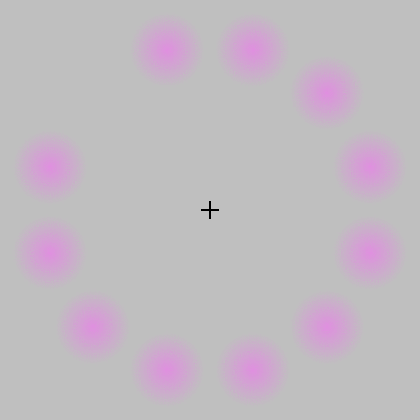Lilac chaser
Lilac Chaser is a visual illusion, also known as the Pac-Man Illusion, that involves a series of lilac, or pale purple, blurs forming a circle around a central point, with one of the blurs disappearing every few moments in sequence. This phenomenon showcases the intricate ways in which the human visual system interprets motion, color, and the disappearance of stimuli. The illusion was popularized on the internet and has been used in various studies to understand perception, afterimage effects, and the neuroscience behind visual phenomena.
Description[edit | edit source]
The Lilac Chaser consists of twelve lilac-colored discs arranged in a circle (like the numbers on a clock) on a grey background. One disc disappears sequentially, moving clockwise around the circle, creating a gap that seems to move. If the viewer stares at the center of the circle for several seconds, several phenomena occur: the gap appears to be a moving green disc, the lilac discs fade away and become invisible (a phenomenon known as Troxler's fading), and if the viewer then shifts their gaze to a different surface, they will see a brief afterimage in a complementary color (green) of the discs.
Mechanism[edit | edit source]
The illusion is a complex interaction of several visual processes. The disappearance of the lilac discs and the appearance of the green disc can be attributed to Troxler's fading, where objects in one's peripheral vision fade away when focusing on a central point for a prolonged period. This effect is enhanced by the motion of the gap, which draws the viewer's attention away from the lilac discs, making them more susceptible to fading.
The green disc seen moving in place of the absent lilac disc is an example of an afterimage. Afterimages occur because photoreceptor cells in the retina of the eye temporarily lose sensitivity from overstimulation. In the case of the Lilac Chaser, staring at the lilac color fatigues specific receptors in the eyes responsible for perceiving it. When the disc disappears, the unstimulated receptors corresponding to the complementary color (green) become more active, creating the illusion of a green disc.
Applications and Significance[edit | edit source]
The Lilac Chaser illusion is more than just a curiosity; it provides valuable insights into the workings of the human visual system. It is used in psychology and neuroscience to study the processes of visual perception, particularly how the brain interprets and gives meaning to visual stimuli that are not directly present. This illusion helps researchers understand how and why the brain fills in gaps in visual information, a fundamental aspect of visual perception that allows us to experience a continuous and stable view of the world despite the frequent blinking of our eyes and the natural blind spots in our visual field.
See Also[edit | edit source]
This article is a psychology-related stub. You can help WikiMD by expanding it!
Search WikiMD
Ad.Tired of being Overweight? Try W8MD's physician weight loss program.
Semaglutide (Ozempic / Wegovy and Tirzepatide (Mounjaro / Zepbound) available.
Advertise on WikiMD
|
WikiMD's Wellness Encyclopedia |
| Let Food Be Thy Medicine Medicine Thy Food - Hippocrates |
Translate this page: - East Asian
中文,
日本,
한국어,
South Asian
हिन्दी,
தமிழ்,
తెలుగు,
Urdu,
ಕನ್ನಡ,
Southeast Asian
Indonesian,
Vietnamese,
Thai,
မြန်မာဘာသာ,
বাংলা
European
español,
Deutsch,
français,
Greek,
português do Brasil,
polski,
română,
русский,
Nederlands,
norsk,
svenska,
suomi,
Italian
Middle Eastern & African
عربى,
Turkish,
Persian,
Hebrew,
Afrikaans,
isiZulu,
Kiswahili,
Other
Bulgarian,
Hungarian,
Czech,
Swedish,
മലയാളം,
मराठी,
ਪੰਜਾਬੀ,
ગુજરાતી,
Portuguese,
Ukrainian
Medical Disclaimer: WikiMD is not a substitute for professional medical advice. The information on WikiMD is provided as an information resource only, may be incorrect, outdated or misleading, and is not to be used or relied on for any diagnostic or treatment purposes. Please consult your health care provider before making any healthcare decisions or for guidance about a specific medical condition. WikiMD expressly disclaims responsibility, and shall have no liability, for any damages, loss, injury, or liability whatsoever suffered as a result of your reliance on the information contained in this site. By visiting this site you agree to the foregoing terms and conditions, which may from time to time be changed or supplemented by WikiMD. If you do not agree to the foregoing terms and conditions, you should not enter or use this site. See full disclaimer.
Credits:Most images are courtesy of Wikimedia commons, and templates, categories Wikipedia, licensed under CC BY SA or similar.
Contributors: Prab R. Tumpati, MD

